HMA is pleased to welcome new experts to our family of companies in April 2023. This diverse team brings significant expertise in Medicare, Medicaid, regulatory strategies, and managed care, strengthening HMA’s capabilities in healthcare consulting across areas like actuarial support, regulatory compliance, and strategic leadership in Medicare Advantage and Medicaid programs.
140 Results found. Clear filters.

Illinois requests Section 1115 waiver extension to address HRSNs and eliminate inequities
This week our In Focus section reviews the Illinois Healthcare Transformation 1115 Waiver Extension request, posted for review on May 12, 2023.
In pursuing this waiver extension, Illinois joins a growing list of states taking advantage of new Centers for Medicare & Medicaid Services (CMS) policy flexibilities to address health-related social needs (HRSNs) through Medicaid and test community-driven initiatives that are focused on improving health equity, improving access to care, and promoting whole-person care.
The Illinois waiver incorporates two of the most significant new opportunities in the CMS demonstration waiver flexibilities by proposing to incorporate housing supports for people who are experiencing or at risk of homelessness. The waiver also would extend community reintegration services for justice-involved adults and youths for up to 90 days before their release from incarceration. For a full list of proposed benefits and demonstrations, see Table 1.
Table 1. Summary of Illinois Medicaid 1115 Waiver Extension
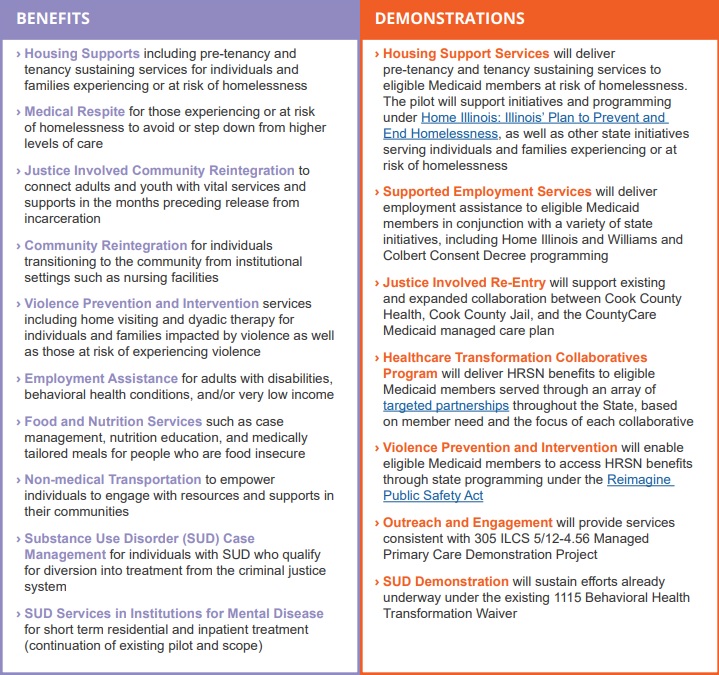
Source: Illinois Department of Health and Family Services. Illinois Healthcare Transformation Section 1115 Demonstration Extension Overview.
The Illinois waiver represents an unprecedented opportunity to demonstrate the long-term, positive impact of providing HRSN services to achieve health equity and create a sustainable, community-driven system for delivering those services. The demonstration proposes to offer a range of HRSN services that are focused on the unmet needs of people who are homeless and housing insecure, are justice-involved, have behavioral health conditions, are pregnant, are unemployed, are food insecure, and/or have been exposed to violence or are at risk of violence with the goal of eliminating health disparities.
The waiver projects a five-year total of $4.4 billion in HRSN services expenditures and another $800 million in HRSN-related infrastructure, indicating Illinois’ long-term commitment to healthcare transformation and to building an equitable, accessible, and high-quality delivery system.
For additional information, please email weeklyroundup@healthmanagement.com.

How will CMS’s proposed rule shift standards for Medicaid enrollee access to services?
This week’s In Focus is the second in a two-part look at the Centers for Medicare & Medicaid Services’ (CMS’s) recently proposed changes to the Medicaid program. Last week we covered CMS’s proposed changes to the federal Medicaid managed care regulations (CMS-2439-P). This week we review the Medicaid Access to Care proposed rule (CMS-2442-P).
As we discussed last week, the managed care and access to care rules include significant changes to core structural and financing aspects of the Medicaid program. Though state agencies, providers, health plans, consumer groups, and other stakeholders will want to understand the distinct requirements and expectations in each rule that apply to them, the proposed changes cannot be viewed in isolation.
The Access to Care rule addresses a range of challenges that shape the experience of Medicaid enrollees, regardless of whether they are in managed care programs or traditional fee-for-service (FFS). The proposed policy changes also are designed to create an updated federal framework for Medicaid’s home and community-based services (HCBS) programs. These proposals come at a pivotal time, as states are facing workforce shortages, particularly among HCBS direct care workers (DCWs).
The remainder of this In Focus delves into notable components of the proposed changes and includes analysis of the implications of these policies for stakeholders. CMS will benefit from stakeholder input; the deadline for submitting comments is July 3, 2023.
Table 1. Access to Care Regulations: Overview of Proposed Changes
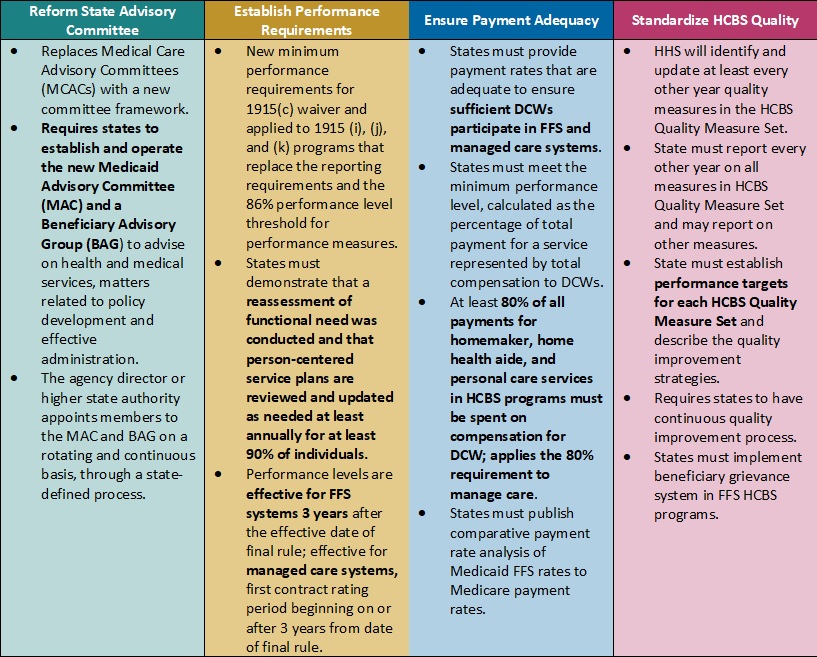
Key Themes and Considerations
Ensuring Payment Adequacy for Key HCBS Services Experiencing Workforce Shortages. One of the most notable proposed changes that would directly impact DCWs is a requirement that at least 80 percent of Medicaid payments be spent on compensation. The proposed rule would apply to homemaker, home health aide, and personal care services, as they represent a large portion of HCBS services that DCWs provide. The proposal is based on feedback from states that have implemented similar provisions, which have ranged from 75 to 90 percent compensation requirements.
CMS specifically seeks stakeholder feedback on the percentage that should be adopted. This policy provision also is important from an equity perspective, given that 90 percent of DCWs are women and 60 percent are members of racial or ethnic minority populations. However, increased or mandated DCW rates may make it difficult for HCBS providers to sustain their businesses as they manage the increased administrative pressures of electronic visit verification, the complexity of filing claims for managed long-term services and supports (MLTSS), and the additional work that HCBS quality measurement may create. Smaller HCBS providers, some of which may have deep cultural expertise, may struggle to sustain themselves and meet these requirements.
Table 2. Access to Care Regulations: Snapshot of Proposed Rate, Access, and Payment Changes
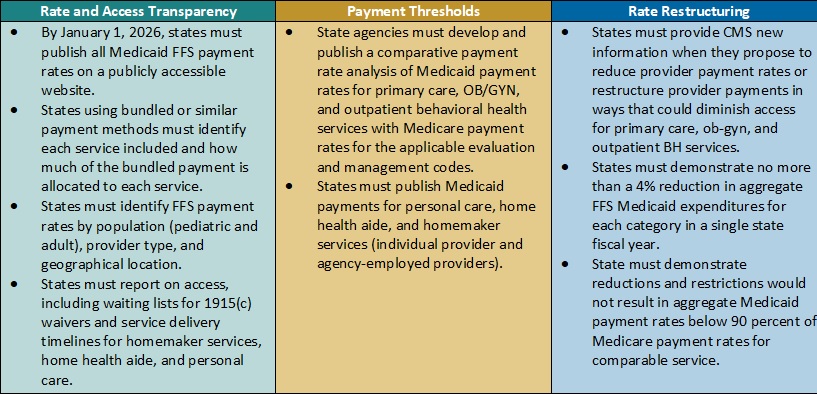
Payment Alignment. CMS is seeking to align access to care strategies and payment rate transparency more closely across the FFS and managed care delivery systems. The proposed rule includes several changes that CMS has developed achieve this goal. For example:
- CMS plans to require that states publish more detailed rate information in a consistent format. States, health plans, providers, and other interested stakeholders will want to consider the implications by delivery system. Additional transparency requirements could create a new opportunity to understand rates across payers and states and use this information in addressing access challenges for services.
- The proposed rule also would require extensive comparative analysis of Medicaid FFS rates and Medicare rates. CMS proposes to use Medicare non-facility payment rates as a benchmark to determine if states are meeting federal Medicaid access State analyses will be vital to CMS oversight as well as advocacy efforts within states to monitor and update FFS rates as needed.
Strengthening the Focus on Quality in State HCBS Programs. Over the last several decades, states and Medicaid stakeholders have made significant progress toward increasing participation in HCBS programs and community integration initiatives to counter Medicaid’s institutional bias. CMS is proposing more consistency in the expectations and reporting for HCBS quality measures to further the impact and create a consistent foundation for the recently mandated HCBS quality initiatives starting to take root.
In the short-term, the proposed changes will require states, and likely downstream providers and Medicaid agencies, to immediately change their quality reporting policies and systems. States and their stakeholders will want to map out processes for cyclical updates to HCBS quality measures, including cross-walking the future measures with existing ones, making systems changes, and updating dashboards. Targeted attention and focus will be needed to identify realistic HCBS performance targets that yield successful improvement strategies in the midst of a workforce crisis. Longer term, it will be necessary to map out when updates and reporting will be required to strengthen the rigor and accountability for state performance in the HCBS quality measure set, as well as reinforce the information available to make policy, clinical, and operational improvements to Medicaid programs.
HCBS Access Measurement. CMS is proposing new FFS HCBS payment and access transparency requirements to ensure compliance with Medicaid provider payment rules that require payments to be adequate to enlist at least the same number of providers that the overall geographic population can access. Because the targeted HCBS services do not have a comparable Medicare rate, CMS proposes implementation of a payment rate disclosure approach that would standardize data and monitoring across service delivery systems, with the goal of improving access. In addition to proposed payment transparency changes, CMS proposed new reporting on HCBS waiver waiting lists and timelines for the start of related services once authorized.
These new reporting requirements will provide stakeholders with more information to benchmark their state’s experience with other providers across the nation. This information could be influential to policymakers and legislators and help uncover some of the core contributors to our nation’s HCBS workforce shortage.
Improving Health Equity with Medicaid Beneficiary Input. CMS proposes overhauling the scope and membership of the state Medical Care Advisory Committee. The new Medicaid Advisory Committee (MAC) would continue to advise the state on health and medical matters and play an expanded advisory role on matters of policy development and effective administration of the program. CMS also plans to require that states establish a Beneficiary Advisory Group (BAG) composed of current or past Medicaid beneficiaries. A subset of BAG members would serve on the MAC to ensure their perspectives are integrated into the committee’s recommendations to states.
Under the new federal requirements, MAC representatives could have greater relative input and influence on policies and actions each state Medicaid agency advances. Medicaid stakeholders will want to ensure the MAC’s minimum federal requirements support effective structures and processes in states.
What’s Next
CMS plans to reframe Medicaid access as one of three parts of the continuum of care, along with enrollment and maintenance of coverage. The proposals in the Access to Care rule would have a meaningful impact on the volume and type of data available to evaluate the relationship between Medicaid payment rates and access across all delivery systems.
States, managed care organizations, providers, Medicaid enrollee advocacy organizations, and other interested stakeholders should analyze the proposals and consider submitting comments to CMS on the feasibility, potential impact, and, where applicable, alternatives to the proposed changes. They also can use this time to begin planning and determine which resources and tools they may need to prepare for implementation of changes across delivery systems in the Medicaid program.
HMA’s experts are taking a wholistic approach to reviewing the Access to Care and Managed Care proposed rules in tandem and identifying key points of intersection.
For more information on the access to care proposed rule, contact our experts below.

What you need to know about CMS’s proposed changes to Medicaid managed care rules
This week, our In Focus section reviews CMS’s proposed changes to the federal Medicaid managed care access, finance, and quality regulation (CMS-2439-P). A future In Focus will take a closer look at the proposed changes to the federal Medicaid access to care regulation (CMS-2442-P), which also has significant implications for state Medicaid programs.
On April 28, 2023, the Centers for Medicare & Medicaid Services (CMS) unveiled two significant and related proposed rules addressing Medicaid managed care access, finance, and quality requirements. Together these proposed rules signal a new era of accountability and transparency in the Medicaid program. They also strengthen beneficiaries’ role in influencing the policies and administration of state Medicaid programs.
Table 1 identifies a few of the key themes and issues addressed in the Medicaid managed care proposed rule. The deadline for submitting comments to CMS is July 3, 2023.
Table 1. Medicaid Managed Care Proposed Rule: Snapshot of Proposed Changes
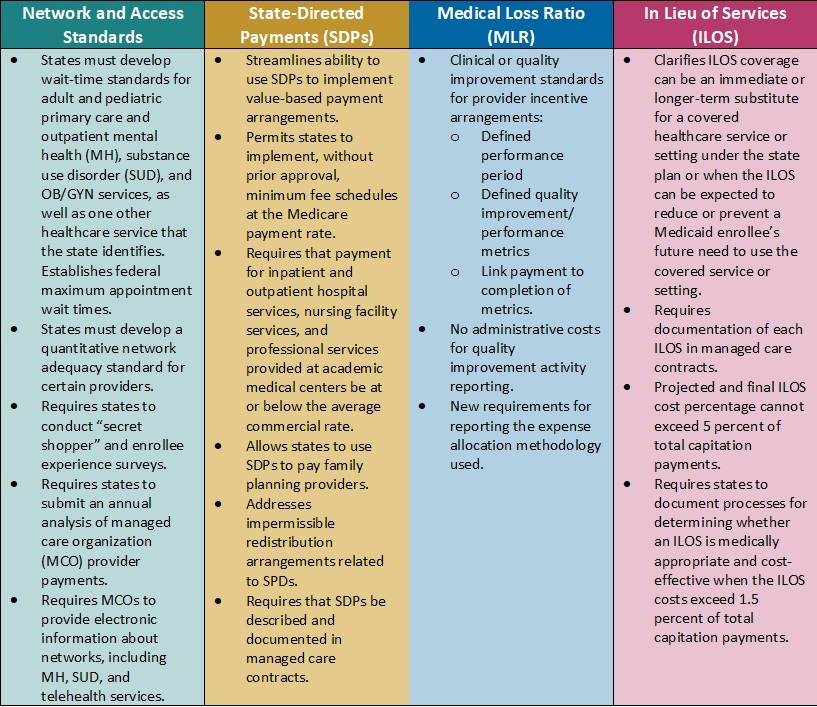
Key Themes and Considerations
Payment Ceilings May Accelerate Value-Based Payment Arrangements. Current federal regulations allow states to direct managed care organizations (MCOs) to pay providers according to specific rates or methods. States have used these directed payment arrangements to set minimum payment rates for certain types of providers or to require participation in value-based payment (VBP) initiatives.
In the proposed rule, CMS calls for establishing an upper limit for these payments. Specifically, the agency plans to limit the projected total payment rates to the average commercial rate (ACR) for inpatient and outpatient hospital services, nursing facility services, and qualified practitioner services at academic medical centers that states include in state-directed payment (SDP) arrangements. The ACR limit, in concert with the proposed SDP documentation and reporting, is among the most significant and complex proposed changes in the rule.
Considerations: The proposed changes represent a strong federal regulatory push to accelerate movement to VBP in Medicaid, which provides states with new levers to drive value in their Medicaid delivery systems. It also means that MCOs, providers, and other stakeholders will need to navigate and help inform the policies and contractual arrangements that will flow from the pending changes. For example, states may need to reflect on the following considerations:
- Whether the proposals will require them to reduce reimbursement
- Whether they will need to develop new value-based arrangements through SDPs and how these policies will be structured
- What outcomes they might need to prioritize
- How transparency in reporting provider-level payments could affect non-federal funding and SDP initiatives
Updated Approach to in Lieu of Services (ILOS) Facilitates Whole-Person Care. In January 2023, CMS issued a State Medicaid Director Letter (SMDL#23-001) advising states of the option to use the ILOS authority in Medicaid managed care programs to reduce healthcare inequities and address unmet health-related social needs (HRSNs), such as housing, food insecurity, and intimate partner violence. The proposed Medicaid managed care rule would expand upon and codify in regulation that guidance.
Considerations: Although the ILOS proposal adds reporting requirements and guardrails to address fiscal accountability, overall, the updated policy signals CMS’s willingness to support innovative state approaches to meet a continuum of beneficiary needs, including HRSNs that affect the social drivers of health. Notably, CMS advises that the substitution of an ILOS for a state plan service or setting should be cost-effective but does not need to be budget-neutral. States also can specify that an ILOS can be an immediate or longer-term substitute for a state plan service or setting.
States could pursue a variety of options under CMS’s revised ILOS framework. State Medicaid agencies and their partners can collaborate on ILOS strategies that will allow them to make further progress toward reducing healthcare inequities, as well as fulfill their quality strategy goals and objectives.
New Standards for Medical Loss Ratio Strengthen Link to Performance Improvement. Existing federal regulations require Medicaid managed care plans to report their medical loss ratio (MLR) to states annually, and, in turn, states must submit a summary of those reports to CMS. Many state MCO contracts require plans to comply with provider incentive and bonus policies; however, MCOs infrequently make incentive payments contingent on the provider meeting quantitative clinical or quality improvement standards.
Consistent with the healthcare sector’s transition toward value-based care, CMS proposes to strengthen the link between an MCOs incentive payment to a provider and the provider meeting defined quality improvement or performance metrics. Additionally, contractual language between MCOs and providers will need to more explicitly identify the dollar amounts tied to successful completion of these metrics. Only incentive payments based on quality improvement will be considered incurred claims when plans calculate their MLR; administrative costs cannot be included in quality improvement activity reporting.
Considerations. The proposed requirements are expected to add more transparency to negotiations between Medicaid MCOs and providers. MCOs will retain flexibility to determine the quality improvement or quantitative performance metrics, which carry more weight and accountability in CMS’s revised regulatory framework.
Network Adequacy Requirements Strengthen Link to Access and Rates. CMS also proposes policies that the agency believes will help strengthen Medicaid enrollees’ access to services. For example, the rule would require states to develop wait-time standards for adult and pediatric primary care and outpatient mental health, substance use disorder (SUD), and OB/GYN services, with CMS establishing federal minimum appointment wait times. States also will need to develop a quantitative network adequacy standard, beyond wait times, for certain providers.
Notably, CMS also plans to require states to submit an MCO-level analysis of MCO-to-provider payments. This analysis may provide more insights about the relationship between rates and access to certain types of providers and services. It may also improve alignment in access policies across delivery systems.
Considerations: States and MCOs should expect to need more sophisticated analysis of provider capacity at state and local market levels. This information will be critical in developing network adequacy standards and determining where additional provider support may be necessary. Expanded and new strategies may be needed to ensure compliance with the federal rules and resulting changes to state policies.
What’s Next
Many of CMS’s proposals track closely with many recent recommendations from federal commissions and oversight entities, including the Medicaid and CHIP Payment and Access Commission (MACPAC) and Government Accountability Office (GAO), which may indicate a greater likelihood that CMS will finalize those policies. If they are finalized largely as proposed, the rule will further the Biden Administration’s directional imprint on the Medicaid program.
Within the proposed rules described above, CMS identifies numerous areas where stakeholder input would be beneficial. States, MCOs, providers, and other interested stakeholders should analyze the proposals and consider submitting comments to CMS on the feasibility, potential impact, and, where applicable, alternatives to the proposed changes. Stakeholders also may use this time to begin planning for 2024 and determining what resources and tools they may need to prepare for implementation of the final regulations, as well as how their approach may vary based on state-specific factors.
For questions about the rule and how HMA’s team of experts can support your organization’s response, please contact our experts below.

Florida releases Medicaid Managed Care ITN
This week our In Focus section reviews the Florida Statewide Medicaid Managed Care Program (SMMC) Invitation to Negotiate (ITN), released on April 11, 2023, by the Florida Agency for Health Care Administration (AHCA). SMMC consists of three programs: Managed Medical Assistance (MMA), Long-term Care (LTC), and dental, covering 4.4 million individuals. This ITN is for contracts to provide MMA and LTC.
Under the SMMC program, all enrollees receive their services from a single plan providing managed medical assistance, long-term care, and specialty benefits. (Dental benefits are provided separately.)
AHCA will select plans that will achieve the agency’s goals, including providing healthy birth outcomes for mothers and their infants, improving childhood and adolescent mental health, maximizing home and community-based placement and services, and supporting the HOPE Florida program. HOPE Florida utilizes ‘Hope Navigators’ to help individuals achieve economic self-sufficiency, develop long term-goals, and map out a strategic plan by focusing on community collaboration between the private sector, faith-based community, nonprofits and government entities.
Additionally, with the new contracts, AHCA will implement the following changes:
- Specialty plans will no longer be awarded separately but must be awarded to a comprehensive or MMA plan.
- Enrolling voluntary recipients (such as individuals with intellectual or developmental disabilities) into the SMMC program and providing the opportunity for them to opt out
- AHCA may mandatorily enroll into the MMA program full benefit dual-eligibles who are also in a Medicare Dual Eligible Special Needs Plan (DSNP).
AHCA will invite 10 plans to negotiate for awards as shown below:
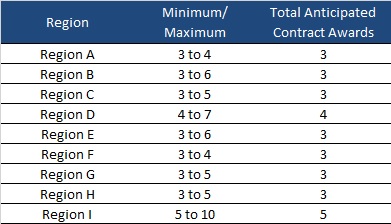
Timeline
Proposals are due August 15, 2023, with an anticipated award date of December 11. Contract will run from October 1, 2024, through December 31, 2030. Contracts may not be renewed, but AHCA may extend the term to cover any delays during the transition to a new plan.

Evaluation
Plans can receive a total maximum number of points of 5,950. AHCA will invite top-ranking plans to negotiations to ensure that AHCA can enter into contracts with the minimum required number of plans per region.
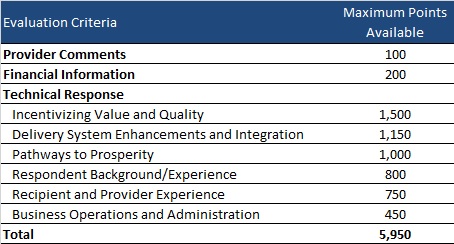
Current Market
As of December 2022, Florida served 4.3 million MMA and LTC enrollees, excluding an additional 97,000 Children’s Medical Services enrollees in the Children’s Medical Services Network plan. Centene had the highest market share based on enrollment, at over 40 percent.
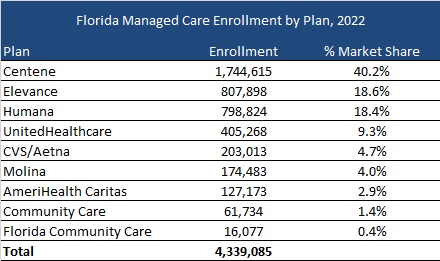

Health Management Associates Acquires Crestline Advisors
Jay Rosen, founder, president, and co-chairman of Health Management Associates (HMA), today announced the firm’s acquisition of Crestline Advisors, an Arizona based healthcare consulting firm.
Founded in 2013, Crestline Advisors supports health plans, provider organizations, and state agencies with an array of services designed to help them navigate the changing healthcare landscape. The company’s team of independent consultants has an extensive track record of developing successful RFP responses, provider networks, and business development strategies to fuel client success.
“Crestline Advisors brings an impressive mix of expertise and relentless client focus – that delivers results – to HMA,” Rosen said. “Their ability to consistently develop winning proposal responses for Medicaid managed care organizations (MCO) complements our extensive MCO supports as we continue to expand the ways in which we serve our clients.”
In addition to Crestline’s proposal response development and MCO network management and operations support services, the company also assists clients with regulatory and contract compliance, accreditation, and strategic planning for business development.
“Crestline has demonstrated a commitment to supporting health plans, providers, and states to improve healthcare for Medicaid beneficiaries,” said Crestline CEO Susan Dess. “We firmly believe that as part of the HMA family of companies we will bring even more success to our clients and drive continued growth and development in Medicaid healthcare delivery.”
Dess and Tim Mechlinski will continue to lead Crestline Advisors, an HMA Company, as managing directors. Terms of the transaction were not disclosed.
About HMA
Founded in 1985, HMA is an independent, national research and consulting firm specializing in publicly funded healthcare and human services policy, programs, financing, and evaluation. Clients include government, public and private providers, health systems, health plans, community-based organizations, institutional investors, foundations, and associations. With offices in more than 20 locations across the country and over 500 multidisciplinary consultants coast to coast, HMA’s expertise, services, and team are always within client reach. Learn more about HMA at healthmanagement.com, or on LinkedIn and Twitter.
About Crestline Advisors
Established in 2013, Crestline Advisors, LLC is a consulting company designed to support the needs of health plans, provider organizations, and state agencies. Crestline specializes in helping large and small organizations operate successfully and grow despite the constant operational, financial, and political challenges they face. Crestline uses its current understanding of industry drivers to strategize with our clients so they can respond timely and effectively to small, large, or enormous market-place changes. Learn more about Crestline Advisors at crestlineadvisors.com.

Medicaid managed care enrollment update – Q4 2022
This week, our In Focus section reviews recent Medicaid enrollment trends in capitated, risk-based managed care in 32 states.[1] Many state Medicaid agencies post monthly enrollment figures by health plan for their Medicaid managed care population to their websites. This data allows for the timeliest analysis of enrollment trends across states and managed care organizations. All 32 states highlighted in this review have released monthly Medicaid managed care enrollment data into the fourth quarter (Q4) of 2022. This report reflects the most recent data posted. HMA will continue tracking enrollment throughout the eligibility redetermination period. HMA has made the following observations related to the enrollment data shown on Table 1 (below):
- The 32 states in this report account for an estimated 71 million Medicaid managed care enrollees as of December 2022. Based on HMA estimates of MCO enrollment in states not covered in this report, we believe that nationwide Medicaid MCO enrollment was likely about 75 million in December 2022. As such, the enrollment data across these 32 states represents approximately 95 percent of all Medicaid MCO enrollment.
- Across the 32 states tracked in this report, Medicaid managed care enrollment is up 7.5 percent year-over-year as of December 2022.
- All states, besides Mississippi, saw increases in enrollment in December 2022, compared to the previous year, due to the gains from the COVID-19 pandemic. Mississippi Medicaid managed care enrollment fell because the state shifted members to FFS during the public health emergency.
- Twenty-three of the 32 states – Arizona, California, District of Columbia, Illinois, Indiana, Iowa, Kentucky, Louisiana, Maryland, Michigan, Minnesota, Missouri, Nebraska, Nevada, New Jersey, New Mexico, New York, Ohio, Oregon, Pennsylvania, Virginia, Washington, and West Virginia – expanded Medicaid under the Affordable Care Act and have seen increased Medicaid managed care enrollment since expansion.
- The 23 expansion states listed above have seen net Medicaid managed care enrollment increase by 3.5 million members, or 7.2 percent, in the past year, to 52.2 million members at the end of 2022.
- The nine states that have not yet expanded Medicaid as of December 2022 – Florida, Georgia, Kansas, Mississippi, North Carolina, South Carolina, Tennessee, Texas, and Wisconsin – have seen Medicaid managed care enrollment increase 8.3 percent to 19 million members at the end of 2022.
Table 1 – Monthly MCO Enrollment by State – July 2022 through December 2022
| Jul-22 | Aug-22 | Sep-22 | Oct-22 | Nov-22 | Dec-22 | |
| Arizona | 2,069,048 | 2,079,360 | 2,095,101 | 2,106,800 | 2,116,444 | 2,127,666 |
| +/- m/m | 8,527 | 10,312 | 15,741 | 11,699 | 9,644 | 11,222 |
| % y/y | 7.6% | 0.0% | 7.5% | 7.4% | 7.2% | 7.1% |
| California | 12,929,500 | 13,013,324 | 13,073,427 | 13,132,616 | 13,231,993 | 13,204,398 |
| +/- m/m | 215,506 | 83,824 | 60,103 | 59,189 | 99,377 | (27,595) |
| % y/y | 9.8% | 9.9% | 9.9% | 9.9% | 10.2% | 9.5% |
| D.C. | 246,957 | 247,704 | 248,577 | 249,617 | 250,676 | |
| +/- m/m | 3,223 | 747 | 873 | 1,040 | 1,059 | N/A |
| % y/y | 6.7% | 6.7% | 6.5% | 6.5% | 6.4% | |
| Florida | 4,385,965 | 4,432,233 | 4,465,670 | 4,502,297 | 4,537,121 | 4,581,266 |
| +/- m/m | 41,441 | 46,268 | 33,437 | 36,627 | 34,824 | 44,145 |
| % y/y | 10.9% | 10.9% | 10.7% | 10.7% | 10.7% | 11.0% |
| Georgia | 1,975,277 | 1,988,727 | 2,016,462 | 2,027,275 | 2,035,673 | |
| +/- m/m | 13,117 | 13,450 | N/A | N/A | 10,813 | 8,398 |
| % y/y | 9.8% | 9.5% | 9.0% | 8.7% | 8.3% | |
| Illinois | 2,890,332 | 2,884,029 | 2,900,232 | 2,929,584 | 2,965,007 | 3,000,717 |
| +/- m/m | (8,672) | (6,303) | 16,203 | 29,352 | 35,423 | 35,710 |
| % y/y | 5.1% | 4.5% | 4.1% | 4.4% | 5.1% | 5.5% |
| Indiana | 1,742,762 | 1,761,692 | 1,769,400 | 1,781,464 | 1,797,451 | 1,813,044 |
| +/- m/m | 6,906 | 18,930 | 7,708 | 12,064 | 15,987 | 15,593 |
| % y/y | 11.6% | 11.3% | 11.0% | 10.5% | 10.2% | 10.3% |
| Iowa | 795,534 | 799,748 | 807,296 | 812,481 | 814,490 | |
| +/- m/m | 2,642 | 4,214 | 7,548 | N/A | N/A | 2,009 |
| % y/y | 5.9% | 5.8% | 6.4% | 6.0% | 6.1% | |
| Kansas | 489,309 | 490,911 | 492,640 | 497,257 | 499,143 | 500,814 |
| +/- m/m | 2,691 | 1,602 | 1,729 | 4,617 | 1,886 | 1,671 |
| % y/y | N/A | N/A | N/A | N/A | 8.3% | 6.3% |
| Kentucky | 1,494,068 | 1,487,387 | 1,509,274 | 1,518,906 | 1,528,484 | 1,534,657 |
| +/- m/m | 6,069 | (6,681) | 21,887 | 9,632 | 9,578 | 6,173 |
| % y/y | 5.5% | 5.3% | 5.6% | 5.8% | 6.7% | 6.1% |
| Louisiana | 1,821,644 | 1,828,015 | 1,833,457 | 1,841,693 | 1,858,092 | 1,860,170 |
| +/- m/m | 7,213 | 6,371 | 5,442 | 8,236 | 16,399 | 2,078 |
| % y/y | 4.6% | 4.5% | 4.4% | 4.7% | 5.2% | 5.8% |
| Maryland | 1,496,677 | 1,502,271 | 1,508,469 | 1,514,381 | 1,521,171 | 1,529,308 |
| +/- m/m | 8,205 | 5,594 | 6,198 | 5,912 | 6,790 | 8,137 |
| % y/y | 6.5% | 6.2% | 6.1% | 5.8% | 5.8% | 5.7% |
| Michigan | 2,280,243 | 2,294,432 | 2,299,913 | 2,309,913 | 2,319,951 | 2,324,046 |
| +/- m/m | 2,923 | 14,189 | 5,481 | 10,000 | 10,038 | 4,095 |
| % y/y | 3.8% | 3.6% | 3.5% | 3.7% | 4.5% | 4.3% |
| Minnesota | 1,261,112 | 1,262,073 | 1,278,954 | 1,286,890 | 1,293,858 | 1,299,194 |
| +/- m/m | 1,893 | 961 | 16,881 | 7,936 | 6,968 | 5,336 |
| % y/y | 7.3% | 6.7% | 7.4% | 7.5% | 7.5% | 7.5% |
| Mississippi | 367,137 | 363,387 | 364,612 | 355,694 | 367,902 | 396,880 |
| +/- m/m | (452) | (3,750) | 1,225 | (8,918) | 12,208 | 28,978 |
| % y/y | -22.7% | -19.9% | -17.4% | -17.3% | -12.5% | -3.9% |
| Missouri | 1,038,239 | 1,065,217 | 1,099,707 | 1,118,373 | 1,136,589 | 1,157,005 |
| +/- m/m | 26,520 | 26,978 | 34,490 | 18,666 | 18,216 | 20,416 |
| % y/y | 27.0% | 29.1% | 32.6% | 31.7% | 31.8% | 29.0% |
| Nebraska | 363,328 | 366,202 | 369,770 | 372,613 | 374,857 | 378,237 |
| +/- m/m | 2,740 | 2,874 | 3,568 | 2,843 | 2,244 | 3,380 |
| % y/y | 12.4% | 11.9% | 11.7% | 11.2% | 10.8% | 10.6% |
| Nevada | 687,362 | 689,139 | 697,752 | 675,465 | 685,736 | 692,890 |
| +/- m/m | 9,464 | 1,777 | 8,613 | (22,287) | 10,271 | 7,154 |
| % y/y | 9.3% | 9.0% | 9.3% | 4.2% | 5.2% | 5.7% |
| New Jersey | 2,100,947 | 2,113,930 | 2,125,181 | 2,130,868 | 2,144,514 | 2,158,966 |
| +/- m/m | 10,897 | 12,983 | 11,251 | 5,687 | 13,646 | 14,452 |
| % y/y | 7.4% | 7.4% | 7.2% | 7.0% | 7.1% | 7.0% |
| New Mexico | 809,991 | 811,732 | 812,995 | 813,630 | 814,466 | 815,798 |
| +/- m/m | 2,491 | 1,741 | 1,263 | 635 | 836 | 1,332 |
| % y/y | 4.2% | 3.7% | 3.4% | 3.0% | 2.6% | 2.3% |
| New York | 5,855,615 | 5,853,108 | 5,878,519 | 5,906,264 | 5,929,288 | 5,961,782 |
| +/- m/m | 39,970 | (2,507) | 25,411 | 27,745 | 23,024 | 32,494 |
| % y/y | 4.5% | 4.3% | 4.2% | 4.3% | 4.5% | 4.6% |
| North Carolina | 1,738,545 | 1,746,948 | 1,757,503 | 1,768,974 | 1,778,199 | 1,837,423 |
| +/- m/m | 9,047 | 8,403 | 10,555 | 11,471 | 9,225 | 59,224 |
| % y/y | 8.0% | 6.8% | 6.7% | 6.6% | 6.6% | 9.5% |
| Ohio | 2,964,731 | 2,963,616 | 2,960,922 | 2,958,666 | 2,961,983 | 2,973,763 |
| +/- m/m | (1,340) | (1,115) | (2,694) | (2,256) | 3,317 | 11,780 |
| % y/y | 3.4% | 2.6% | 1.9% | 1.4% | 1.0% | 0.9% |
| Oregon | 1,193,358 | 1,202,198 | 1,206,520 | 1,211,099 | 1,221,435 | 1,228,054 |
| +/- m/m | 3,920 | 8,840 | 4,322 | 4,579 | 10,336 | 6,619 |
| % y/y | 8.3% | 8.4% | 7.7% | 7.6% | 7.4% | 7.2% |
| Pennsylvania | 2,895,837 | 2,909,985 | 2,920,584 | 2,937,049 | 2,950,613 | 2,966,207 |
| +/- m/m | 13,973 | 14,148 | 10,599 | 16,465 | 13,564 | 15,594 |
| % y/y | 7.4% | 7.3% | 6.9% | 6.8% | 6.6% | 6.5% |
| South Carolina | 1,055,785 | 1,063,445 | 1,069,569 | 1,078,094 | 1,084,529 | 1,089,577 |
| +/- m/m | 5,226 | 7,660 | 6,124 | 8,525 | 6,435 | 5,048 |
| % y/y | 7.6% | 7.5% | 7.4% | 7.9% | 7.6% | 7.5% |
| Tennessee | 1,692,395 | 1,704,398 | 1,710,125 | 1,718,539 | 1,726,603 | 1,734,108 |
| +/- m/m | 6,737 | 12,003 | 5,727 | 8,414 | 8,064 | 7,505 |
| % y/y | 6.0% | 6.1% | 6.1% | 6.0% | 5.9% | 5.8% |
| Texas | 5,466,045 | 5,653,169 | ||||
| +/- m/m | N/A | N/A | N/A | N/A | N/A | N/A |
| % y/y | 8.6% | 10.6% | ||||
| Virginia | 1,572,923 | 1,582,973 | 1,589,722 | 1,598,875 | 1,608,840 | 1,619,311 |
| +/- m/m | 11,829 | 10,050 | 6,749 | 9,153 | 9,965 | 10,471 |
| % y/y | 11.3% | 11.0% | 10.0% | 9.6% | 10.1% | 9.8% |
| Washington | 1,884,734 | 1,898,983 | 1,904,127 | 1,913,230 | 1,927,690 | 1,959,278 |
| +/- m/m | 8,867 | 14,249 | 5,144 | 9,103 | 14,460 | 31,588 |
| % y/y | #DIV/0! | #DIV/0! | 5.8% | 5.9% | 6.0% | 7.2% |
| West Virginia | 519,992 | 524,042 | 524,922 | 527,226 | 530,494 | 533,194 |
| +/- m/m | 2,871 | 4,050 | 880 | 2,304 | 3,268 | 2,700 |
| % y/y | 6.5% | 6.8% | 6.4% | 5.9% | 5.9% | 5.7% |
| Wisconsin | 1,161,202 | 1,166,208 | 1,172,719 | 1,179,204 | 1,184,899 | 1,190,673 |
| +/- m/m | 5,263 | 5,006 | 6,511 | 6,485 | 5,695 | 5,774 |
| % y/y | 7.5% | 7.2% | 7.1% | 7.1% | 6.9% | 6.6% |
Note: In Table 1 above and the state tables below, “+/- m/m” refers to the enrollment change from the previous month. “% y/y” refers to the percentage change in enrollment from the same month in the previous year.
Below, we provide a state-specific analysis of recent enrollment trends in the states where HMA tracks data.
It is important to note the limitations of the data presented. First, not all states report the data at the same time during the month. Some of these figures reflect beginning-of-the-month totals, while others reflect an end-of-the-month snapshot. Second, in some cases the data is comprehensive in that it covers all state-sponsored health programs for which the state offers managed care; in other cases, the data reflects only a subset of the broader Medicaid managed care population. This is the key limiting factor in comparing the data described below and figures reported by publicly traded Medicaid MCOs. Consequently, the data we review in Table 1 and throughout the In Focus section should be viewed as a sampling of enrollment trends across these states rather than a comprehensive comparison, which cannot be developed based on publicly available monthly enrollment data.
State-Specific Analysis
Arizona
Medicaid Expansion Status: Expanded January 1, 2014
Enrollment in Arizona’s two Medicaid managed care programs grew to 2.1 million in December 2022, up 7.1 percent from December 2021.
| Jul-22 | Aug-22 | Sep-22 | Oct-22 | Nov-22 | Dec-22 | |
| Acute Care | 2,002,584 | 2,012,802 | 2,028,335 | 2,039,880 | 2,049,311 | 2,060,376 |
| ALTCS | 66,464 | 66,558 | 66,766 | 66,920 | 67,133 | 67,290 |
| Total Arizona | 2,069,048 | 2,079,360 | 2,095,101 | 2,106,800 | 2,116,444 | 2,127,666 |
| +/- m/m | 8,527 | 10,312 | 15,741 | 11,699 | 9,644 | 11,222 |
| % y/y | 7.6% | 7.5% | 7.4% | 7.2% | 7.1% |
California
Medicaid Expansion Status: Expanded January 1, 2014
Medi-Cal managed care enrollment was up 9.5 percent year-over-year to 13.2 million, as of December 2022.
| Jul-22 | Aug-22 | Sep-22 | Oct-22 | Nov-22 | Dec-22 | |
| Two-Plan Counties | 8,356,137 | 8,409,817 | 8,446,514 | 8,481,885 | 8,548,096 | 8,588,418 |
| Imperial/San Benito | 100,384 | 101,117 | 101,633 | 102,064 | 102,881 | 103,437 |
| Regional Model | 364,066 | 366,437 | 368,624 | 370,361 | 373,402 | 375,473 |
| GMC Counties | 1,435,250 | 1,445,532 | 1,452,127 | 1,458,149 | 1,470,122 | 1,391,421 |
| COHS Counties | 2,561,831 | 2,578,747 | 2,593,003 | 2,608,731 | 2,625,795 | 2,634,112 |
| Duals Demonstration | 111,832 | 111,674 | 111,526 | 111,426 | 111,697 | 111,537 |
| Total California | 12,929,500 | 13,013,324 | 13,073,427 | 13,132,616 | 13,231,993 | 13,204,398 |
| +/- m/m | 215,506 | 83,824 | 60,103 | 59,189 | 99,377 | (27,595) |
| % y/y | 9.8% | 9.9% | 9.9% | 9.9% | 10.2% | 9.5% |
District of Columbia
Medicaid Expansion Status: Expanded January 1, 2014
Medicaid managed care enrollment in the District of Columbia was up 6.4 percent to almost 251,000 in November 2022.
| Jul-22 | Aug-22 | Sep-22 | Oct-22 | Nov-22 | |
| Total District of Columbia | 246,957 | 247,704 | 248,577 | 249,617 | 250,676 |
| +/- m/m | 3,223 | 747 | 873 | 1,040 | 1,059 |
| % y/y | 6.7% | 6.7% | 6.5% | 6.5% | 6.4% |
Florida
Medicaid Expansion Status: Not Expanded
Florida’s statewide Medicaid managed care program had seen an 11 percent rise in total covered lives over the last year to nearly 4.6 million beneficiaries as of December 2022. (Note that the managed LTC enrollment figures listed below are a subset of the Managed Medical Assistance (MMA) enrollments and are included in the MMA number; they are not separately added to the total to avoid double counting).
| Jul-22 | Aug-22 | Sep-22 | Oct-22 | Nov-22 | Dec-22 | |
| MMA | 3,908,539 | 3,948,929 | 3,978,098 | 4,010,534 | 4,041,816 | 4,080,381 |
| LTC (Subset of MMA) | 124,107 | 124,691 | 125,397 | 126,144 | 126,720 | 126,621 |
| SMMC Specialty Plan | 332,179 | 338,057 | 342,325 | 346,516 | 350,058 | 355,638 |
| FL Healthy Kids | 145,247 | 145,247 | 145,247 | 145,247 | 145,247 | 145,247 |
| Total Florida | 4,385,965 | 4,432,233 | 4,465,670 | 4,502,297 | 4,537,121 | 4,581,266 |
| +/- m/m | 41,441 | 46,268 | 33,437 | 36,627 | 34,824 | 44,145 |
| % y/y | 10.9% | 10.9% | 10.7% | 10.7% | 10.7% | 11.0% |
Georgia
Medicaid Expansion Status: Not Expanded
As of December 2022, Georgia’s Medicaid managed care program covered more than 2 million members, up 8.3 percent from the previous year.
| Jul-22 | Aug-22 | Sep-22 | Oct-22 | Nov-22 | Dec-22 | |
| Total Georgia | 1,975,277 | 1,988,727 | 2,016,462 | 2,027,275 | 2,035,673 | |
| +/- m/m | 13,117 | 13,450 | 10,813 | 8,398 | ||
| % y/y | 9.8% | 9.5% | 9.0% | 8.7% | 8.3% |
Illinois
Medicaid Expansion Status: Expanded January 1, 2014
Illinois enrollment across the state’s managed care programs was up 5.5 percent to 3 million as of December 2022.
| Jul-22 | Aug-22 | Sep-22 | Oct-22 | Nov-22 | Dec-22 | |
| HealthChoice | 2,800,420 | 2,793,124 | 2,809,689 | 2,839,342 | 2,874,700 | 2,909,303 |
| Duals Demonstration | 89,912 | 90,905 | 90,543 | 90,242 | 90,307 | 91,414 |
| Total Illinois | 2,890,332 | 2,884,029 | 2,900,232 | 2,929,584 | 2,965,007 | 3,000,717 |
| +/- m/m | (8,672) | (6,303) | 16,203 | 29,352 | 35,423 | 35,710 |
| % y/y | 5.1% | 4.5% | 4.1% | 4.4% | 5.1% | 5.5% |
Indiana
Medicaid Expansion Status: Expanded in 2015 through HIP 2.0
As of December 2022, enrollment in Indiana’s managed care programs—Hoosier Healthwise, Hoosier Care Connect, and Healthy Indiana Program (HIP)—was more than 1.8 million, up 10.3 percent from the previous year.
| Jul-22 | Aug-22 | Sep-22 | Oct-22 | Nov-22 | Dec-22 | |
| Hoosier Healthwise | 845,910 | 852,904 | 857,952 | 863,973 | 869,613 | 876,606 |
| Hoosier Care Connect | 102,805 | 102,819 | 102,537 | 102,253 | 102,200 | 102,150 |
| HIP | 794,047 | 805,969 | 808,911 | 815,238 | 825,638 | 834,288 |
| Indiana Total | 1,742,762 | 1,761,692 | 1,769,400 | 1,781,464 | 1,797,451 | 1,813,044 |
| +/- m/m | 6,906 | 18,930 | 7,708 | 12,064 | 15,987 | 15,593 |
| % y/y | 11.6% | 11.3% | 11.0% | 10.5% | 10.2% | 10.3% |
Iowa
Medicaid Expansion Status: Expanded January 1, 2014
Iowa launched its statewide Medicaid managed care program in April of 2016. Enrollment across all populations was nearly 814,500, as of December 2022. Enrollment was up 6.1 percent from the previous year.
| Jul-22 | Aug-22 | Sep-22 | Oct-22 | Nov-22 | Dec-22 | |
| Traditional Medicaid | 507,266 | 510,618 | 516,556 | 520,234 | 521,118 | |
| Iowa Wellness Plan | 237,910 | 239,261 | 242,555 | 244,724 | 246,385 | |
| hawk-i | 50,358 | 49,869 | 48,185 | 47,523 | 46,987 | |
| Total Iowa | 795,534 | 799,748 | 807,296 | 812,481 | 814,490 | |
| +/- m/m | 2,642 | 4,214 | 7,548 | 2,009 | ||
| % y/y | 5.9% | 5.8% | 6.4% | 6.0% | 6.1% |
Kansas
Medicaid Expansion Status: Not Expanded
Kansas Medicaid managed care enrollment was nearly 501,000 as of December 2022, up 6.3 percent from the previous year.
| Jul-22 | Aug-22 | Sep-22 | Oct-22 | Nov-22 | Dec-22 | |
| Total Kansas | 489,309 | 490,911 | 492,640 | 497,257 | 499,143 | 500,814 |
| +/- m/m | 2,691 | 1,602 | 1,729 | 4,617 | 1,886 | 1,671 |
| % y/y | 8.3% | 6.3% |
Kentucky
Medicaid Expansion Status: Expanded January 1, 2014
As of December 2022, Kentucky covered more than 1.5 million beneficiaries in risk-based managed care. Total enrollment was up 6.1 percent from the prior year.
| Jul-22 | Aug-22 | Sep-22 | Oct-22 | Nov-22 | Dec-22 | |
| Total Kentucky | 1,494,068 | 1,487,387 | 1,509,274 | 1,518,906 | 1,528,484 | 1,534,657 |
| +/- m/m | 6,069 | (6,681) | 21,887 | 9,632 | 9,578 | 6,173 |
| % y/y | 5.5% | 5.3% | 5.6% | 5.8% | 6.7% | 6.1% |
Louisiana
Medicaid Expansion Status: Expanded July 1, 2016
Medicaid managed care enrollment in Louisiana was more than 1.86 million as of December 2022, up 5.8 percent from the previous year.
| Jul-22 | Aug-22 | Sep-22 | Oct-22 | Nov-22 | Dec-22 | |
| Total Louisiana | 1,821,644 | 1,828,015 | 1,833,457 | 1,841,693 | 1,858,092 | 1,860,170 |
| +/- m/m | 7,213 | 6,371 | 5,442 | 8,236 | 16,399 | 2,078 |
| % y/y | 4.6% | 4.5% | 4.4% | 4.7% | 5.2% | 5.8% |
Maryland
Medicaid Expansion Status: Expanded January 1, 2014
Maryland’s Medicaid managed care program covered more than 1.5 million lives as of December 2022.
| Jul-22 | Aug-22 | Sep-22 | Oct-22 | Nov-22 | Dec-22 | |
| Total Maryland | 1,496,677 | 1,502,271 | 1,508,469 | 1,514,381 | 1,521,171 | 1,529,308 |
| +/- m/m | 8,205 | 5,594 | 6,198 | 5,912 | 6,790 | 8,137 |
| % y/y | 6.5% | 6.2% | 6.1% | 5.8% | 5.8% | 5.7% |
Michigan
Medicaid Expansion Status: Expanded April 1, 2014
As of December 2022, Michigan’s Medicaid managed care was up 4.3 percent to 2.3 million.
| Jul-22 | Aug-22 | Sep-22 | Oct-22 | Nov-22 | Dec-22 | |
| Medicaid | 2,239,937 | 2,251,810 | 2,256,800 | 2,265,219 | 2,274,763 | 2,279,473 |
| MI Health Link (Duals) | 40,306 | 42,622 | 43,113 | 44,694 | 45,188 | 44,573 |
| Total Michigan | 2,280,243 | 2,294,432 | 2,299,913 | 2,309,913 | 2,319,951 | 2,324,046 |
| +/- m/m | 2,923 | 14,189 | 5,481 | 10,000 | 10,038 | 4,095 |
| % y/y | 3.8% | 3.6% | 3.5% | 3.7% | 4.5% | 4.3% |
Minnesota
Medicaid Expansion Status: Expanded January 1, 2014
As of December 2022, enrollment across Minnesota’s multiple managed Medicaid programs was nearly 1.3 million, up 7.5 percent from the prior year.
| Jul-22 | Aug-22 | Sep-22 | Oct-22 | Nov-22 | Dec-22 | |
| Parents/Kids | 748,197 | 748,513 | 758,100 | 763,044 | 767,798 | 770,918 |
| Expansion Adults | 272,666 | 273,387 | 278,421 | 281,284 | 284,073 | 288,680 |
| Senior Care Plus | 24,190 | 24,252 | 25,344 | 25,914 | 26,415 | 26,740 |
| Senior Health Options | 43,429 | 43,686 | 43,920 | 44,162 | 44,248 | 44,324 |
| Special Needs BasicCare | 64,656 | 64,484 | 65,562 | 65,763 | 65,987 | 66,171 |
| Moving Home Minnesota | 11 | 11 | 10 | 10 | 9 | 11 |
| Minnesota Care | 107,963 | 107,740 | 107,597 | 106,713 | 105,328 | 102,350 |
| Total Minnesota | 1,261,112 | 1,262,073 | 1,278,954 | 1,286,890 | 1,293,858 | 1,299,194 |
| +/- m/m | 1,893 | 961 | 16,881 | 7,936 | 6,968 | 5,336 |
| % y/y | 7.3% | 6.7% | 7.4% | 7.5% | 7.5% | 7.5% |
Mississippi
Medicaid Expansion Status: Not Expanded
MississippiCAN, the state’s Medicaid managed care program, had membership down 3.9 percent to nearly 397,000 as of December 2022.
| Jul-22 | Aug-22 | Sep-22 | Oct-22 | Nov-22 | Dec-22 | |
| Total Mississippi | 367,137 | 363,387 | 364,612 | 355,694 | 367,902 | 396,880 |
| +/- m/m | (452) | (3,750) | 1,225 | (8,918) | 12,208 | 28,978 |
| % y/y | -22.7% | -19.9% | -17.4% | -17.3% | -12.5% | -3.9% |
Missouri
Medicaid Expansion Status: Expansion Enrollment began in October 2021
Missouri managed care enrollment in the Medicaid and CHIP programs was nearly 1.2 million in December 2022.
| Jul-22 | Aug-22 | Sep-22 | Oct-22 | Nov-22 | Dec-22 | |
| Total Medicaid | 758,928 | 757,312 | 769,419 | 775,076 | 782,863 | 787,611 |
| Total CHIP | 28,949 | 28,937 | 29,026 | 29,121 | 29,231 | 29,402 |
| Total AEG | 199,963 | 228,361 | 250,131 | 262,612 | 272,574 | 287,692 |
| Total SHK | 50,399 | 50,607 | 51,131 | 51,564 | 51,921 | 52,300 |
| Total Missouri | 1,038,239 | 1,065,217 | 1,099,707 | 1,118,373 | 1,136,589 | 1,157,005 |
| +/- m/m | 26,520 | 26,978 | 34,490 | 18,666 | 18,216 | 20,416 |
| % y/y | 27.0% | 29.1% | 32.6% | 31.7% | 31.8% | 29.0% |
Nebraska
Medicaid Expansion Status: Expanded October 1, 2020
As of December 2022, Nebraska’s Medicaid managed care program enrolled 378,000 members, up 10.6 percent from the previous year.
| Jul-22 | Aug-22 | Sep-22 | Oct-22 | Nov-22 | Dec-22 | |
| Total Nebraska | 363,328 | 366,202 | 369,770 | 372,613 | 374,857 | 378,237 |
| +/- m/m | 2,740 | 2,874 | 3,568 | 2,843 | 2,244 | 3,380 |
| % y/y | 12.4% | 11.9% | 11.7% | 11.2% | 10.8% | 10.6% |
Nevada
Medicaid Expansion Status: Expanded January 1, 2014
Nevada’s Medicaid managed care enrollment was up 5.7 percent to nearly 693,000 as of December 2022.
| Jul-22 | Aug-22 | Sep-22 | Oct-22 | Nov-22 | Dec-22 | |
| Total Nevada | 687,362 | 689,139 | 697,752 | 675,465 | 685,736 | 692,890 |
| +/- m/m | 9,464 | 1,777 | 8,613 | (22,287) | 10,271 | 7,154 |
| % y/y | 9.3% | 9.0% | 9.3% | 4.2% | 5.2% | 5.7% |
New Jersey
Medicaid Expansion Status: Expanded January 1, 2014
As of December 2022, New Jersey Medicaid managed care enrollment was up 7 percent to nearly 2.2 million.
| Jul-22 | Aug-22 | Sep-22 | Oct-22 | Nov-22 | Dec-22 | |
| Total New Jersey | 2,100,947 | 2,113,930 | 2,125,181 | 2,130,868 | 2,144,514 | 2,158,966 |
| +/- m/m | 10,897 | 12,983 | 11,251 | 5,687 | 13,646 | 14,452 |
| % y/y | 7.4% | 7.4% | 7.2% | 7.0% | 7.1% | 7.0% |
New Mexico
Medicaid Expansion Status: Expanded January 1, 2014
As of December 2022, New Mexico’s Centennial Care program covered nearly 816,000 members, up 2.3 percent from the previous year.
| Jul-22 | Aug-22 | Sep-22 | Oct-22 | Nov-22 | Dec-22 | |
| Total New Mexico | 809,991 | 811,732 | 812,995 | 813,630 | 814,466 | 815,798 |
| +/- m/m | 2,491 | 1,741 | 1,263 | 635 | 836 | 1,332 |
| % y/y | 4.2% | 3.7% | 3.4% | 3.0% | 2.6% | 2.3% |
New York
Medicaid Expansion Status: Expanded January 1, 2014
New York’s Medicaid managed care programs collectively covered nearly 6 million beneficiaries as of December 2022, a 4.6 percent increase from the previous year. The Medicaid Advantage program ended in December 2021.
| Jul-22 | Aug-22 | Sep-22 | Oct-22 | Nov-22 | Dec-22 | |
| Mainstream MCOs | 5,399,089 | 5,395,489 | 5,418,915 | 5,446,409 | 5,467,467 | 5,494,358 |
| Managed LTC | 255,999 | 256,538 | 258,236 | 257,360 | 260,087 | 264,965 |
| Medicaid Advantage | 0 | 0 | 0 | 0 | 0 | 0 |
| Medicaid Advantage Plus | 34,357 | 34,355 | 34,689 | 34,764 | 34,717 | 35,061 |
| HARP | 164,514 | 165,067 | 165,024 | 166,063 | 165,340 | 165,713 |
| FIDA-IDD (Duals) | 1,656 | 1,659 | 1,655 | 1,668 | 1,677 | 1,685 |
| Total New York | 5,855,615 | 5,853,108 | 5,878,519 | 5,906,264 | 5,929,288 | 5,961,782 |
| +/- m/m | 39,970 | (2,507) | 25,411 | 27,745 | 23,024 | 32,494 |
| % y/y | 4.5% | 4.3% | 4.2% | 4.3% | 4.5% | 4.6% |
North Carolina
Medicaid Expansion Status: Not Expanded
As of December 2022, enrollment in North Carolina’s Medicaid managed care program was 1.8 million, up 9.5 percent from the prior year. North Carolina implemented Medicaid managed care on July 1, 2021.
| Jul-22 | Aug-22 | Sep-22 | Oct-22 | Nov-22 | Dec-22 | |
| Total North Carolina | 1,738,545 | 1,746,948 | 1,757,503 | 1,768,974 | 1,778,199 | 1,837,423 |
| +/- m/m | 9,047 | 8,403 | 10,555 | 11,471 | 9,225 | 59,224 |
| % y/y | 8.0% | 6.8% | 6.7% | 6.6% | 6.6% | 9.5% |
Ohio
Medicaid Expansion Status: Expanded January 1, 2014
As of December 2022, enrollment across all four Ohio Medicaid managed care programs was nearly 3 million, up 0.9 percent from the prior year.
| Jul-22 | Aug-22 | Sep-22 | Oct-22 | Nov-22 | Dec-22 | |
| CFC Program | 1,800,781 | 1,800,038 | 1,798,135 | 1,796,327 | 1,798,873 | 1,804,860 |
| ABD/Duals | 348,071 | 348,176 | 347,461 | 347,371 | 347,473 | 347,839 |
| Group 8 (Expansion) | 815,879 | 815,402 | 815,326 | 814,968 | 815,637 | 821,064 |
| Total Ohio | 2,964,731 | 2,963,616 | 2,960,922 | 2,958,666 | 2,961,983 | 2,973,763 |
| +/- m/m | (1,340) | (1,115) | (2,694) | (2,256) | 3,317 | 11,780 |
| % y/y | 3.4% | 2.6% | 1.9% | 1.4% | 1.0% | 0.9% |
Oregon
Medicaid Expansion Status: Expanded January 1, 2014
As of December 2022, enrollment in the Oregon Coordinated Care Organization (CCO) Medicaid managed care program was more than 1.2 million, up 7.2 percent from the previous year.
| Jul-22 | Aug-22 | Sep-22 | Oct-22 | Nov-22 | Dec-22 | |
| Total Oregon | 1,193,358 | 1,202,198 | 1,206,520 | 1,211,099 | 1,221,435 | 1,228,054 |
| +/- m/m | 3,920 | 8,840 | 4,322 | 4,579 | 10,336 | 6,619 |
| % y/y | 8.3% | 8.4% | 7.7% | 7.6% | 7.4% | 7.2% |
Pennsylvania
Medicaid Expansion Status: Expanded January 1, 2015
As of December 2022, Pennsylvania’s Medicaid managed care enrollment was nearly 3 million, up 6.5 percent in the past year.
| Jul-22 | Aug-22 | Sep-22 | Oct-22 | Nov-22 | Dec-22 | |
| Total Pennsylvania | 2,895,837 | 2,909,985 | 2,920,584 | 2,937,049 | 2,950,613 | 2,966,207 |
| +/- m/m | 13,973 | 14,148 | 10,599 | 16,465 | 13,564 | 15,594 |
| % y/y | 7.4% | 7.3% | 6.9% | 6.8% | 6.6% | 6.5% |
South Carolina
Medicaid Expansion Status: Not Expanded
South Carolina’s Medicaid managed care programs collectively enrolled nearly 1.1 million members as of December 2022, which represents an increase of 7.5 percent in the past year.
| Jul-22 | Aug-22 | Sep-22 | Oct-22 | Nov-22 | Dec-22 | |
| Total Medicaid | 1,041,909 | 1,049,706 | 1,056,026 | 1,064,548 | 1,071,016 | 1,076,146 |
| Total Duals Demo | 13,876 | 13,739 | 13,543 | 13,546 | 13,513 | 13,431 |
| Total South Carolina | 1,055,785 | 1,063,445 | 1,069,569 | 1,078,094 | 1,084,529 | 1,089,577 |
| +/- m/m | 5,226 | 7,660 | 6,124 | 8,525 | 6,435 | 5,048 |
| % y/y | 7.6% | 7.5% | 7.4% | 7.9% | 7.6% | 7.5% |
Tennessee
Medicaid Expansion Status: Not Expanded
As of December 2022, TennCare managed care enrollment totaled 1.7 million, up 5.8 percent from the prior year.
| Jul-22 | Aug-22 | Sep-22 | Oct-22 | Nov-22 | Dec-22 | |
| Total Tennessee | 1,692,395 | 1,704,398 | 1,710,125 | 1,718,539 | 1,726,603 | 1,734,108 |
| +/- m/m | 6,737 | 12,003 | 5,727 | 8,414 | 8,064 | 7,505 |
| % y/y | 6.0% | 6.1% | 6.1% | 6.0% | 5.9% | 5.8% |
Texas
Medicaid Expansion Status: Not Expanded
Texas’ state fiscal year begins in September and program-specific enrollment is only reported at the end of each state fiscal quarter. As of November 2022, Texas Medicaid managed care enrollment was nearly 5.7 million across the state’s six managed care programs, up 10.6 percent from the previous year.
| Jul-22 | Aug-22 | Sep-22 | Oct-22 | Nov-22 | Dec-22 | |
| STAR | 4,559,293 | 4,748,820 | ||||
| STAR+PLUS | 559,746 | 568,456 | ||||
| STAR HEALTH | 45,760 | 46,228 | ||||
| Duals Demo | 34,336 | 33,673 | ||||
| CHIP | 97,153 | 85,773 | ||||
| STAR KIDS | 169,757 | 170,219 | ||||
| Total Texas | 5,466,045 | 5,653,169 | ||||
| +/- m/m | ||||||
| % y/y | 8.6% | 10.6% |
Virginia
Medicaid Expansion Status: January 1, 2019
Virginia Medicaid managed care enrollment was up 9.8 percent in December 2022 to 1.6 million members.
| Jul-22 | Aug-22 | Sep-22 | Oct-22 | Nov-22 | Dec-22 | |
| Total Virginia | 1,572,923 | 1,582,973 | 1,589,722 | 1,598,875 | 1,608,840 | 1,619,311 |
| +/- m/m | 11,829 | 10,050 | 6,749 | 9,153 | 9,965 | 10,471 |
| % y/y | 11.3% | 11.0% | 10.0% | 9.6% | 10.1% | 9.8% |
Washington
Medicaid Expansion Status: Expanded January 1, 2014
Washington’s Medicaid managed care enrollment increased 7.2 percent to nearly 2 million as of December 2022, compared to the previous year.
| Jul-22 | Aug-22 | Sep-22 | Oct-22 | Nov-22 | Dec-22 | |
| Total Washington | 1,884,734 | 1,898,983 | 1,904,127 | 1,913,230 | 1,927,690 | 1,959,278 |
| +/- m/m | 8,867 | 14,249 | 5,144 | 9,103 | 14,460 | 31,588 |
| % y/y | #DIV/0! | #DIV/0! | 5.8% | 5.9% | 6.0% | 7.2% |
West Virginia
Medicaid Expansion Status: Expanded January 1, 2014
As of December 2022, West Virginia’s Medicaid managed care program covered 533,000 members, up 5.7 percent year-over-year.
| Jul-22 | Aug-22 | Sep-22 | Oct-22 | Nov-22 | Dec-22 | |
| Total West Virginia | 519,992 | 524,042 | 524,922 | 527,226 | 530,494 | 533,194 |
| +/- m/m | 2,871 | 4,050 | 880 | 2,304 | 3,268 | 2,700 |
| % y/y | 6.5% | 6.8% | 6.4% | 5.9% | 5.9% | 5.7% |
Wisconsin
Medicaid Expansion Status: Not Expanded
Across Wisconsin’s three Medicaid managed care programs, December 2022 enrollment totaled nearly 1.2 million, up 6.6 percent from the year before.
| Jul-22 | Aug-22 | Sep-22 | Oct-22 | Nov-22 | Dec-22 | |
| BadgerCare+ | 1,042,456 | 1,047,217 | 1,053,361 | 1,059,587 | 1,065,182 | 1,070,788 |
| SSI | 61,841 | 61,916 | 62,065 | 62,129 | 62,165 | 62,293 |
| LTC | 56,905 | 57,075 | 57,293 | 57,488 | 57,552 | 57,592 |
| Total Wisconsin | 1,161,202 | 1,166,208 | 1,172,719 | 1,179,204 | 1,184,899 | 1,190,673 |
| +/- m/m | 5,263 | 5,006 | 6,511 | 6,485 | 5,695 | 5,774 |
| % y/y | 7.5% | 7.2% | 7.1% | 7.1% | 6.9% | 6.6% |
More Information Available from HMA Information Services
More detailed information on the Medicaid managed care landscape is available from HMA Information Services (HMAIS), which collects Medicaid enrollment data, health plan financials, and the latest on expansions, waivers, duals, ABD populations, long-term care, accountable care organizations, and patient-centered medical homes. HMAIS also includes a public documents library with copies of Medicaid RFPs, responses, model contracts, and scoring sheets.
HMAIS enhances this publicly available information with an overview of the structure of Medicaid in each state, as well as proprietary Medicaid Managed Care RFP calendars.
[1] Arizona, California, District of Columbia, Florida, Georgia, Illinois, Indiana, Iowa, Kansas, Kentucky, Louisiana, Maryland, Michigan, Minnesota, Mississippi, Missouri, Nebraska, Nevada, New Jersey, New Mexico, New York, North Carolina, Ohio, Oregon, Pennsylvania, South Carolina, Tennessee, Texas, Virginia, Washington, West Virginia, Wisconsin.

Health Management Associates acquires Lovell Communications and establishes Nashville office
Jay Rosen, founder, president, and co-chairman of Health Management Associates (HMA), today announced the firm’s acquisition of Lovell Communications, a leading strategic communications and change management firm that exclusively serves the healthcare industry.
Founded in 1988 and based in Nashville, Tenn., award-winning Lovell Communications provides communication solutions and strategies for healthcare organizations across the country. Lovell has helped clients of all size manage crises, navigate change, maximize brand potential, and grow business. Services include creation of corporate communication programs, marketing and media strategies, transaction support, and helping clients navigate complex operational, reputational and regulatory issues.
“Lovell’s strategists have an impressive track record of helping healthcare clients overcome challenges and seize opportunities,” Rosen said. “They are a natural addition to our company as we open a Nashville office and continue to expand the depth and breadth of services we offer our clients and partners.”
Lovell CEO Rosemary Plorin will continue to lead the firm, which will operate as Lovell Communications, an HMA Company. In addition to serving integrated health systems, hospitals and providers across the country, Lovell’s clients include healthcare suppliers, consultants, associations and innovators throughout the industry.
“As the pace of transformation in healthcare continuously increases, the need for effective, strategic communications has never been greater,” Plorin said. “We are honored to offer our expertise in support of HMA’s clients and look forward to what we will accomplish together as we pursue a shared commitment to making healthcare more accessible, equitable and effective.”
HMA’s new Nashville office is co-located with the Lovell office in the Westpark Building at 3212 West End Ave.
About HMA
Founded in 1985, HMA is an independent, national research and consulting firm specializing in publicly funded healthcare and human services policy, programs, financing, and evaluation. Clients include government, public and private providers, health systems, health plans, community-based organizations, institutional investors, foundations, and associations. With offices in more than 20 locations across the country and over 500 multidisciplinary consultants coast to coast, HMA’s expertise, services, and team are always within client reach.
About Lovell Communications
For 35 years Lovell Communications has served as strategic counsel and trusted partner to health care providers and suppliers across the country. Publicly traded companies, not-for-profit systems, early stage and mature companies draw upon the firm’s vast communications expertise to support them through phases – or just moments – when it is crucial to persuade audiences or influence decision makers. Learn more about the firm at Lovell.com, or on Twitter, Facebook or the company blog.
HMA: https://www.healthmanagement.com/
Lovell Communications: https://www.lovell.com/

Lee Fleisher of CMS to keynote HMA national quality conference
Join us on Monday, March 6, 2023, at the Fairmont Chicago, Millennium Park, for “Healthcare Quality Conference: A Deep Dive on What’s Next for Providers, Payers, and Policymakers,” where Lee Fleisher, MD, chief medical officer and director of CMS’ Center for Clinical Standards and Quality, will deliver the keynote titled A Vision for Healthcare Quality: How Policy Can Drive Improved Outcomes.
HMA’s first annual quality conference will provide organizations the opportunity to “Focus on Quality to Improve Patients’ Lives.” Attendees will hear from industry leaders and policy makers about evolving health care quality initiatives and participate in substantive workshops where they will learn about and discuss solutions that are using quality frameworks to create a more equitable health system.
In addition to Fleisher, featured speakers will executives from ANCOR, CareOregon, Commonwealth Care Alliance, Council on Quality and Leadership, Intermountain Healthcare, NCQA, Reema Health, Kaiser Permanente, United Hospital Fund, and others.
Working sessions will provide expert-led discussions about how quality is driving federal and state policy, behavioral health integration, approaches to improving equity and measuring the social determinants of health, integration of disability support services, stronger Medicaid core measures, strategies for Medicare Star Ratings, value-based payments, and digital measures and measurement tools. Speakers will provide case studies and innovative approaches to ensuring quality efforts result in lasting improvements in health outcomes.
“What’s different about this conference is that participants will engage in working sessions that provide healthcare executives tools and models for directly impacting quality at their organizations,” said Carl Mercurio, Principal and Publisher, HMA Information Services.
Early Bird registration ends January 30. Visit the conference website for complete details. Group rates and sponsorships are available.

Texas releases STAR & CHIP managed care services RFP
This week, our In Focus section reviews the State of Texas Access Reform (STAR), Children’s Health Insurance Program (CHIP), and Healthy Texas Women (HTW) Medicaid managed care request for proposals (RFP) released by the Texas Health and Human Services Commission (HHSC) on December 7, 2022. Medicaid managed care organizations (MCOs) will serve over 4.6 million members. Prior STAR & CHIP program contracts were valued at roughly $9.7 billion annually, with new contracts to be worth more.
Background
Texas is currently in the process of rebidding all of its Medicaid managed care programs. A former STAR & CHIP RFP was cancelled in March 2020.
STAR is Texas’ traditional Medicaid program. Under the STAR program, MCOs will provide preventive, primary, acute care, behavioral health (including mental health and substance-use disorder counseling and treatment), Non-Emergency Medical Transportation (NEMT), and pharmacy services to eligible pregnant women, newborns, children, and parents with limited income.
CHIP is the state-federal jointly funded program covering children whose families who earn too much to qualify for Medicaid but cannot afford private insurance. In Texas, CHIP contracts also include the CHIP Perinatal Program covering pregnant women who are ineligible for Medicaid due to income or immigration status to receive prenatal care for their unborn children. Once born, newborns receive 12 months of continuous coverage.
The HTW program provides family planning services, family planning-related services, and other preconception women’s health services. The HTW program was originally a fee-for-service program until the Centers for Medicare & Medicaid Services (CMS) approved a Section 1115 waiver demonstration in January 2020. Texas is currently waiting on CMS approval for a waiver amendment to also add HTW Plus, an enhanced postpartum benefits package, into Medicaid managed care.
RFP
HHSC intends to award at least three contracts for each service area (SA). The maximum number of MCOs that will be awarded in the new procurement for each SA is shown below.
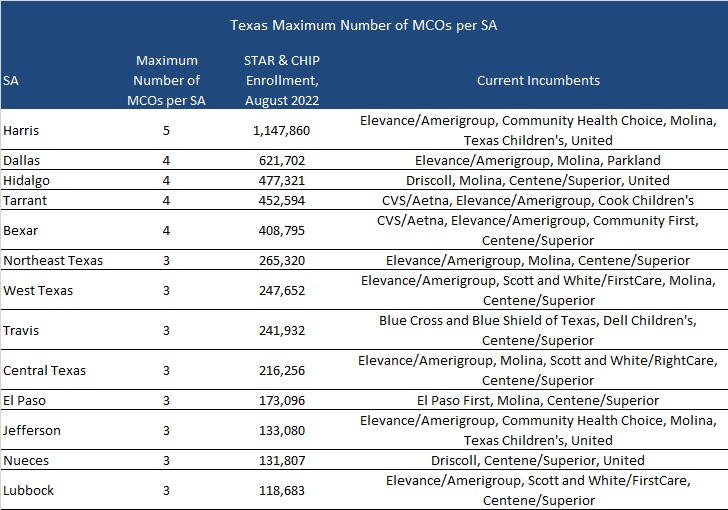
As of August 2022, STAR enrollment was 4.56 million and CHIP enrollment was over 97,000.
Timeline
A preproposal conference will be held on December 21, 2022. While optional, the conference is recommended and will include training on the completion of the Historically Underutilized Business (HUB) Subcontracting Plan. Proposals will be due February 17, 2023, with awards anticipated in February 2024. Implementation is expected February 2025. Contracts will run for six years, with three two-year renewal options, not to exceed a total contract term of 12 years.

Evaluation
MCOs will be scored out of 2,000 points as shown below. HHSC will recommend contract awards in SAs based on MCOs’ final weighted scores and will take consideration of MCOs’ ranking of SAs by preference.
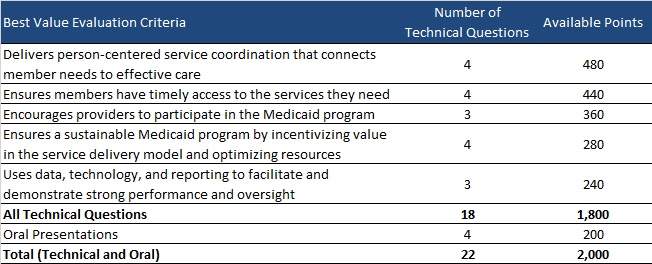
Each MCO can be awarded contracts in up to seven SAs. However, HHSC may choose to award more per MCO if the SA has not reached a maximum number of MCOs.
Link to RFP

2022 Yearly Roundup: a year of successful partnerships
The holiday season is grounded in gratitude. At HMA, we are grateful for successful partnerships that have fueled change to improve lives.
We are proud to be trusted advisors to our clients and partners. Their success is our success. In 2022 our clients and partners made significant strides tackling the biggest healthcare challenges, seizing opportunities for growth and innovation, and shaping the healthcare landscape in a way that improves the health and wellness of individuals and communities.
Reforming Colorado’s Behavioral Health System
HMA partnered with the Colorado Department of Human Services to support the planning and implementation of a new Behavioral Health Administration (BHA). HMA provided technical research and extensive stakeholder engagement, drafted models for forming and implementing the BHA, employed an extensive change management approach, and created a detailed implementation plan with ongoing support. Today the BHA is a cabinet member-led agency that collaborates across agencies and sectors to drive a comprehensive and coordinated strategic approach to behavioral health.
Wakely Consulting Group, an HMA Company, was engaged to support the launch of a Medicare Advantage (MA) joint venture partnership between a health plan and a provider system. Wakely was responsible for preparing and certifying MA and Medicare Part D (PD) bids, a highly complex, exacting, and iterative effort. The Wakely team quickly became a trusted advisor and go-to resource for the joint venture decision makers. The joint venture has driven significant market growth over its initial years, fueled by a competitive benefit package determined by the client product team.
Laying the Foundation for Modernizing Indiana’s Public Health System
In 2021 Indiana Governor Eric Holcomb appointed a 15-member commission to assess Indiana’s public health system and make recommendations for improvements. The Indiana Department of Health (IDOH) engaged HMA to provide extensive project management and support for six workstreams. HMA prepared a draft report summarizing public input as well as research findings and recommendations. The commission’s final report will form the basis of proposed 2023 legislation, including proposals to substantially increase public health service and funding across the state.
Multiple Clients Accepted into ACO REACH Model
In early 2022 HMA and Wakely Consulting Group, an HMA Company, assisted multiple clients with their applications to participate in the new CMS ACO REACH model. The purpose of this model is to improve quality of care for Medicare beneficiaries through better care coordination and increased engagement between providers and patients including those who are underserved. The team tailored their support depending on each client’s needs. The application selection process was highly competitive. Of the 271 applications received, CMS accepted just under 50 percent. Notably, nine out of the 10 organizations HMA and Wakely supported were accepted into the model.
Pipeline Research and Policy Recommendations to Address New Innovative Therapies
HMA, and subsidiaries The Moran Company and Leavitt Partners, were selected by a large pharmaceutical manufacturer to analyze the current pipeline of innovative therapies, examine reimbursement policies to assess long-term compatibility with the adoption of innovative therapies and novel delivery mechanisms, and make policy recommendations to address any challenges identified through the process. The project equipped the client with a holistic understanding of future potential impacts and actions to address challenges in a detailed pipeline analysis of innovative therapies.

Oklahoma rereleases Medicaid managed care RFPs
This week, our In Focus reviews the Oklahoma Medicaid managed care SoonerSelect Program request for proposals (RFP) and the SoonerSelect Children’s Specialty Program RFP released by the Oklahoma Health Care Authority (OHCA) on November 10, 2022.
Background
Oklahoma currently does not have a fully capitated, risk-based Medicaid managed care program. The majority of the state’s 1.3 million Medicaid members are in SoonerCare Choice, a Primary Care Case Management (PCCM) program in which each member has a medical home. Other programs include SoonerCare Traditional (Medicaid fee-for-service), SoonerPlan (a limited benefit family planning program), and Insure Oklahoma (a premium assistance program for low-income people whose employers offer health insurance).
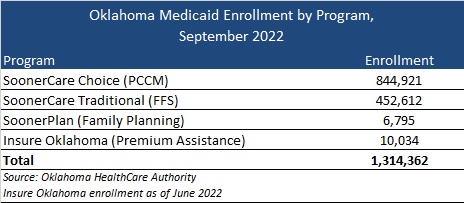
Prior efforts to transition to Medicaid managed care have encountered roadblocks, starting in 2017 with a failed attempt to move aged, blind, and disabled members to managed care.
More recently, in June 2021, the Oklahoma Supreme Court struck down a planned transition of the state’s traditional Medicaid program to managed care, ruling that the Oklahoma Health Care Authority does not have the authority to implement the program without legislative approval.
Contracts had been awarded to Blue Cross Blue Shield of Oklahoma, Humana, Centene/Oklahoma Complete Health, and UnitedHealthcare. Centene/Oklahoma Complete Health also won an award for the SoonerSelect Children’s Specialty Program.
In May 2022, Governor Kevin Stitt signed a new Oklahoma law to implement Medicaid managed care by October 1, 2023.
SoonerSelect RFP
Oklahoma will award contracts to at least three entities to provide medical, behavioral, and pharmacy coverage to nearly one million eligible children, pregnant women, newborns, parents and caretake relatives, and the expansion population. However, enrollment in these populations is expected to drop following the end of the public health emergency (PHE).
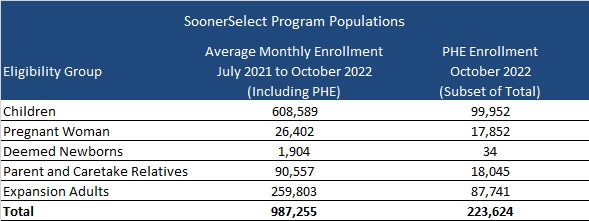
At least one of the contracts may be awarded to a provider-led entity (PLE). PLEs would need to provide proof that a majority of their ownership is held by Oklahoma Medicaid providers or the majority of the governing body is composed of individuals who have experience serving Medicaid members and are licensed providers. PLEs would also be able to bid on urban regions if the PLE agrees to develop statewide readiness within a timeframe set by the OHCA. If no PLEs meet OHCA standards, Oklahoma can choose not to award a PLE.
Goals of the program will include:
- Improve health outcomes for Medicaid members and the state as a whole
- Ensure budget predictability through shared risk and accountability
- Ensure access to care, quality measures, and member satisfaction
- Ensure efficient and cost-effective administrative systems and structures
- Ensure a sustainable delivery system that is a provider-led effort and that is operated and managed by providers to the maximum extent possible.
Timeline
Proposals will be due on February 8, 2023, and contract implementation is scheduled for October 1, 2023. The contract is expected to run through June 30, 2024, with five, one-year options.

Evaluation
Bidder’s technical proposals will be scored out of a total 1550 points. OHCA will award PLEs an additional 50 points for qualifying, bringing the total up to 1600 points. OHCA may also choose to conduct oral presentations for an extra total of 50 points.
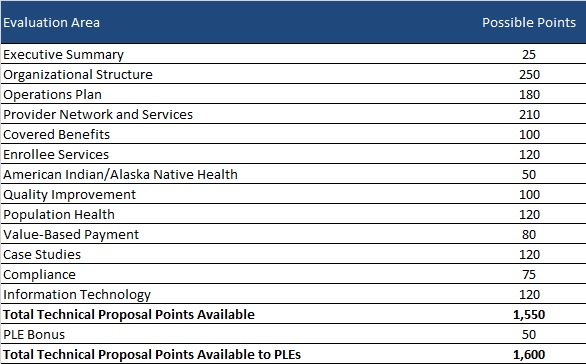
SoonerSelect Children’s Specialty Program RFP
Oklahoma will select one of the awarded SoonerSelect plans for a separate statewide contract to provide comprehensive integrated health coverage to foster children, former foster children up to 25 years of age, juvenile justice-involved children, and children receiving adoption assistance. Contract terms will be the same as the main SoonSelect procurement, running from October 1, 2023, through June 30, 2024, with five one-year renewal options.







